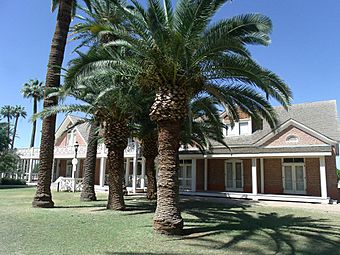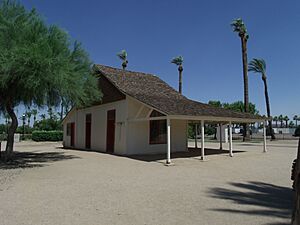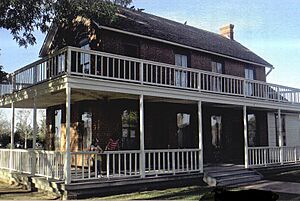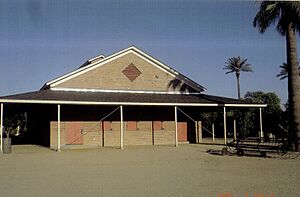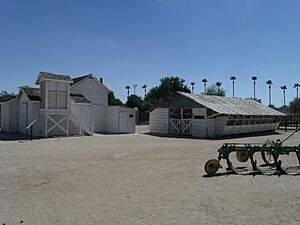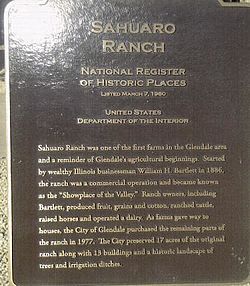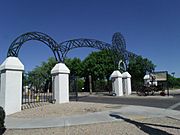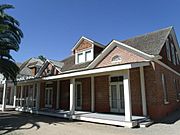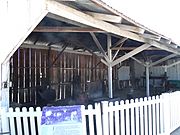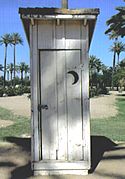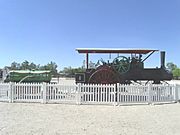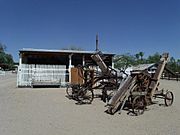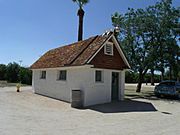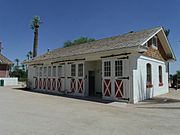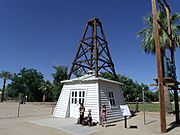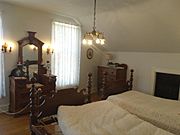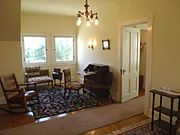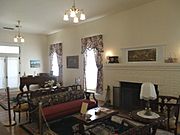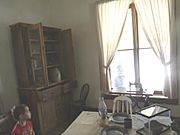Sahuaro Ranch facts for kids
Sahuaro Ranch is a historic place in Glendale, Arizona. It was started in 1886 by William Henry Bartlett. The ranch was known for its many fig and fruit trees, grapevines, and fields of alfalfa. Today, all of its old buildings have been fixed up. The "Sahuaro Ranch Park" is now managed by the Parks and Recreation Department of Glendale.
Sahuaro Ranch was added to the National Register of Historic Places on March 7, 1980. This means it's an important place to protect because of its history.
Contents
Ranch History and Owners
The Bartlett Family Era (1880 - 1913)
William Henry Bartlett and his brother were successful business owners from Peoria, Illinois. They decided to claim land in what would become the city of Glendale. This area became very appealing after the Arizona Canal was finished in 1885. The canal brought water to 100,000 acres of desert land. This made it possible for people to claim land and start farms. The Homestead Act was a United States law that allowed people to get farmland for free.
The Bartlett brothers saw a great chance to invest in fruit farming. They owned a large business that traded grain in the Midwest. By 1891, William Bartlett controlled 2,000 acres of farmland near Glendale. He started a 640-acre farm and called it Sahuaro Ranch. He planted many citrus and pecan trees there.
Even though William Bartlett never lived at Sahuaro Ranch full-time, he was very involved in its growth. He had many buildings and homes built for his family and the people who worked there. He hired managers to run the ranch every day.
The first building on the ranch was an adobe house, built in 1881. It was used as the home and office for Stephen H. Campbell, the first ranch manager. Later, in 1895, the main house became the manager's home. The adobe house was then used for ranch workers. Bartlett had his workers plant figs, other fruits, grapes, and alfalfa.
Other buildings were added in the 1890s. These included the Foreman's House, the blacksmith shop, and the horse barn. The Fruit Packing House was built in 1891. It was the biggest packing house in the Salt River Valley.
The ranch also raised many farm animals, like cows, bulls, and hogs. In the 1890s, between 500 and 1,000 hogs were raised there. Horses and mules were used to pull wagons, mowers, and other farm tools.
The Guest House was built in 1898. Bartlett's youngest son became sick with tuberculosis while living in Chicago. His doctor suggested he move to a warmer place. So, Bartlett designed the guest house to be comfortable for his son and his family.
In 1901, Bartlett built a pump house. It had an oil-powered electrical generator. This generator provided electricity to the ranch buildings and helped pump water. By 1905, the first cars were used on the ranch. Bartlett then built a garage to store both his wagons and cars.
The Bradshaw (1913 - 1927) and Smith (1927 - 1977) Eras
In 1913, Peter E. Bradshaw bought the ranch. He started planting long-staple cotton in 1915.
In 1927, Richard W. Smith purchased the ranch. He planted many citrus and pecan trees. In 1928, Smith built a dairy barn. He raised dairy cows to sell their milk. The milk was sold in large amounts and sent to local dairies in cans.
Richard W. Smith passed away in 1944. His son, Richard S. Smith, took over the farm. He started a retail dairy on the ranch called the Sahuaro Jersey Dairy Milk House.
In the early 1960s, 120 acres of the ranch were sold. This land was used to build the Glendale Community College campus.
Sahuaro Ranch Becomes a Historic Place
In 1966, the City of Glendale, led by Mayor Max Klass, began to buy 80 acres of the original ranch. In 1977, the city was able to buy the land with help from a federal grant. Glendale then started to fix up the old buildings on the ranch. After the city bought the land, Richard S. Smith was allowed to rent the ranch until 1980.
On March 7, 1980, Sahuaro Ranch was officially added to the National Register of Historic Places. The city had applied for 17 acres of the ranch to be registered. Today, the ranch is open to everyone. You can find it at 9802 North 59th Avenue and Mountain View.
The Sahuaro Ranch Fire
In September 2017, the ranch had several fires. These happened on September 18, 23, and 26. The blacksmith shop, granary building, and milk house all caught fire and were completely destroyed. This was a sad loss for the community because these were important historical buildings. The park was closed on September 26, 2017, for an investigation. It reopened the next day.
In February 2018, a 14-year-old was arrested for being on the property on the night of September 26, 2017. This was the night of the biggest fire at the park. However, no proof was ever found to connect the teen to any other crimes, like setting the fires on purpose.
The damaged buildings were rebuilt and opened again in February 2020. They were made to look as much like the original buildings as possible. The city of Glendale used old photos and memories from staff to match the look. Much of the wood was brought from Flagstaff to be as natural as possible, just like it would have been in the early 1900s.
Gallery of Historical Sahuaro Ranch
-
Outhouse (1890).
- Images of the 19th Century interior furnishings and decorations of the Main Mansion and Adobe house.
See also


